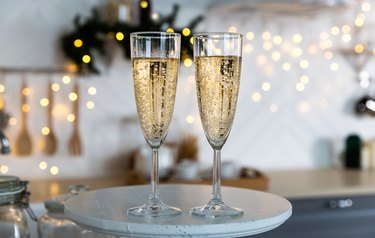
Liquid bubble lights provide both interest and nostalgia to your holiday decorations. However, they do pose a hidden danger, so make sure you understand how liquid bubble lights work and how to use bubble lights safely.
History of Bubble Lights
Video of the Day
First introduced in 1956, bubble lights are brightly colored, made of glass and shaped liked a candle with a wide base and narrow tube. They were developed by the NOMA Electric Corporation. Although they are not as popular today nor as safe and energy-efficient as LED Christmas lights, they are a fun alternative to consider when decorating for the holidays.
Video of the Day
You can string bubble lights on your tree or display them on a mantle or windowsill. Some people enjoy using bubble lights as a centerpiece.
How Do Bubble Lights Work?
Bubble lights provide beautiful colors and moving light as the bubbles move through the liquid. So, how does a bubble light work? The glass tubes of the lights are filled with the liquid chemical methylene chloride, which has a very low boiling point. When the lights are turned on, the methylene chloride begins to boil, and the bubbles are illuminated by the light in the base.
For a period of time, the company Raylite made bubble lights out of oil and pumice, which bubbled when combined. However, these lights were discontinued.
Each light is designed as a bulb that can be screwed in. This means that you can replace individual bubble lights without replacing the entire string. In addition, the strings are generally wired so that if one light goes out, the other lights are not affected.
Dangers of Bubble Lights
Large bubble lights make wonderful decorations, but they can be dangerous for pets and children. When decorating with bubble lights, make sure that the lights remain upright at all times. In addition, the glass tube of the light is fairly fragile, so handle the lights with care so that you don't break the light.
If you do break the bubble light, keep children and pets away from the broken light. Not only can the shards of glass cause injury but the methylene chloride is also highly toxic when it contacts the skin or is inhaled or ingested. The body converts the chemical into carbon dioxide and causes symptoms of carbon dioxide poisoning, including drowsiness, headache, nausea and vomiting. In severe cases, it can cause coma, heart attack, seizures and death.
If you or your children come into contact with methylene chloride, call poison control or your doctor right away for treatment. If your pets come into contact with the chemical, call your veterinarian, the Pet Poison Helpline or the American Society for the Prevention of Cruelty to Animals Poison Control Center. Do not attempt to give any home remedies or attempt to induce vomiting unless instructed to do so by a doctor, veterinarian or poison control center.
Other Holiday Decor Dangers
Bubble lights are not the only dangers you may encounter when decorating for the holidays, especially when you opt for a nostalgic or vintage feel. Some people enjoy the look and feel of mercury glass ornaments. New ornaments aren't made with mercury, but antique ornaments are, and this can be highly toxic if the glass is broken, exposing mercury to the air.
Many old ornaments may also be decorated with lead paint, which can be very dangerous, especially if a child decides to put the ornament in his mouth. Even without toxic components, many small decorations and ornaments should be kept away from small children, as they can be a choking hazard.